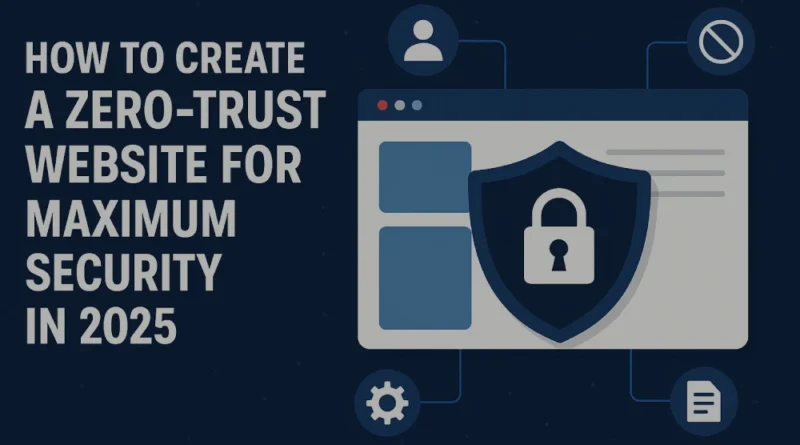How to Create a Zero-Trust Website for Maximum Security in 2025
Traditional perimeter-based security measures cannot stop present-day cyber threats, which remain active in evolution. Businesses along with developers must implement zero-trust website security approaches by 2025 for developing a strong protection against contemporary threats. The methodology removes all unsanctioned trust by constantly monitoring all users and devices that want to access website materials. The guide demonstrates an approach for implementing secure website design 2025 principles through a zero-trust website security strategy both for new site construction and existing infrastructure enhancement.
What is Zero-Trust and Why It Matters
Website security implemented with zero trust follows the essential approach that users should never be automatically trusted since verification must be a perpetual process. The website perceives every online request for access as an impending security threat regardless of user type. Traditional security models grant network access to users upon entry but zero-trust enforces uninterrupted authentication of all internal and external users.
The security demands of web design match zero-trust principles because the main objective is minimizing the threat zone and safeguarding vital data and APIs and backend infrastructure from unauthorized activity. Moving into 2025 zero-trust website security becomes an absolute requirement due to advancing AI attacks and automated bots which develop intricate threat tactics.
Key Pillars of Secure Website Design 2025
1. Identity and Access Management (IAM)
- Implement role-based access controls (RBAC).
- MFA security protocols should protect both administrators and users' authentication processes.
- The system must grant simple permissions to enter different layers within its structure.
IAM forms the foundation of zero-trust website security because it grants access to authenticated users who possess appropriate roles for accessing specific assets.
2. HTTPS Everywhere & TLS 1.3
- All pages of your website must operate under HTTPS by utilizing TLS 1.3.
- You need to execute routine updates for SSL/TLS certificates and replace them with new ones.
- Monitor for certificate transparency violations.
The requirement for encryption of website traffic during transit became essential for secure website design in 2025 because it prevents both eavesdropping and MITM attacks.
3. Microsegmentation and Network Controls
A web infrastructure segmentation technique enables you to contain compromised segments to prevent attackers from spreading throughout your infrastructure. Apply geo-blocking and rate limiting and WAFs together to create security webs design that follows proper principles.
4. Continuous Monitoring and Analytics
- Use Security Information and Event Management (SIEM) tools as a security deployment.
- Your system should use behavioral analytics to find abnormal patterns as they occur.
- AI-based detection systems must be deployed for identifying new zero-day security risks.
The visibility of user behavior patterns and request activities and any peculiar activities enables developers and security personnel to perform swift and effective responses as part of cybersecurity web design.
5. Secure Development Lifecycle (SDLC)
Program development follows five fundamental stages which need to contain security verification measures starting from design through to coding and testing until software deployment.
- Companies must conduct persistent checks on their codebase together with their dependency components.
- An organization should implement both static and dynamic analysis instruments for running SAST/DAST tests.
- Automate patching and vulnerability management.
The secure website design 2025 methodology requires developers to move security initiatives “left” into early development stages in order to decrease potential vulnerabilities in the future.
Best Practices for Cybersecurity Web Design in 2025
Following these security best practices in web design will help you maintain leadership against changing threats.
- The implementation of Zero-trust security gates requires combined use with Content Security Policies and both XSS and Cookie defense strategies.
- CAPTCHA solutions and bot protection systems should be deployed because they help defend websites from credential stuffing attacks and brute-force attempts.
- Your website needs decentralized authentication through the implementation of both OAuth 2.1 and WebAuthn security systems.
- Quarterly penetration testing should discover covert system weak points within the infrastructure.
- These methods form a comprehensive cybersecurity web design strategy which lowers the risk of security breaches occurring.
Real-World Application: How Businesses Are Using Zero-Trust in 2025
The major platforms operating e-commerce businesses along with SaaS companies are rebuilding their sites based on secure website design 2025 frameworks. Financial services platforms combine behavioral authentication features into their security process alongside healthcare entities using encrypted API systems alongside decentralized ID protocols.
The integration of innovation with security measures enables platforms to maintain regulatory compliance and build trustworthy relationships with customers, which creates marketplace advantages in privacy-oriented markets.
The Future is Zero-Trust
A foundation of zero-trust website security must exist to develop websites that will be secure and future-ready for 2025. Security practices in modern web design, when integrated with zero-trust website models, create a defensive system that protects users and brand reputation along with data.
Modern security standards now demand organizations to abandon faith in internal networks while also abandoning nonchalant examination of user activities. Companies should welcome secure website design 2025 through the integration of ground-up zero-trust website security principles. All developers at different levels from individuals to corporate architects can preserve their website security in the next generation of cyber threats by implementing these practices.
Disclaimer
The information presented in this blog is derived from publicly available sources for general use, including any cited references. While we strive to mention credible sources whenever possible, Web Techneeq– Top Website Design Company in Mumbai does not guarantee the accuracy of the information provided in any way. This article is intended solely for general informational purposes. It should be understood that it does not constitute legal advice and does not aim to serve as such. If any individual(s) make decisions based on the information in this article without verifying the facts, we explicitly reject any liability that may arise as a result. We recommend that readers seek separate guidance regarding any specific information provided here.

